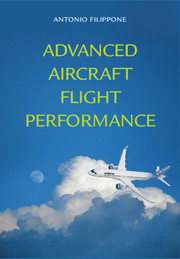Book contents
- Frontmatter
- Contents
- Tables
- Preface
- Nomenclature
- Technology Warning
- 1 Prolegomena
- 2 Aircraft Models
- 3 Weight and Balance Performance
- 4 Aerodynamic Performance
- 5 Engine Performance
- 6 Propeller Performance
- 7 Airplane Trim
- 8 Flight Envelopes
- 9 Take-Off and Field Performance
- 10 Climb Performance
- 11 Descent and Landing Performance
- 12 Cruise Performance
- 13 Manoeuvre Performance
- 14 Thermo-Structural Performance
- 15 Mission Analysis
- 16 Aircraft Noise: Noise Sources
- 17 Aircraft Noise: Propagation
- 18 Aircraft Noise: Flight Trajectories
- 19 Environmental Performance
- 20 Epilogue
- Appendix A Gulfstream G-550
- Appendix B Certified Aircraft Noise Data
- Appendix C Options for the FLIGHT Program
- Index
- References
14 - Thermo-Structural Performance
Published online by Cambridge University Press: 05 January 2013
- Frontmatter
- Contents
- Tables
- Preface
- Nomenclature
- Technology Warning
- 1 Prolegomena
- 2 Aircraft Models
- 3 Weight and Balance Performance
- 4 Aerodynamic Performance
- 5 Engine Performance
- 6 Propeller Performance
- 7 Airplane Trim
- 8 Flight Envelopes
- 9 Take-Off and Field Performance
- 10 Climb Performance
- 11 Descent and Landing Performance
- 12 Cruise Performance
- 13 Manoeuvre Performance
- 14 Thermo-Structural Performance
- 15 Mission Analysis
- 16 Aircraft Noise: Noise Sources
- 17 Aircraft Noise: Propagation
- 18 Aircraft Noise: Flight Trajectories
- 19 Environmental Performance
- 20 Epilogue
- Appendix A Gulfstream G-550
- Appendix B Certified Aircraft Noise Data
- Appendix C Options for the FLIGHT Program
- Index
- References
Summary
Overview
This chapter deals with thermodynamic and structural models of various aircraft sub-systems. Two main aero-thermodynamic problems are discussed: cold-weather operation (§ 14.1), including aircraft icing (§ 14.1.1), and fuel temperature in the aircraft tanks (§ 14.3 and § 14.4). Basic characteristics of aircraft fuels are discussed in § 14.2. A lumped-mass model for thermo-structural performance of aircraft tyres is presented in § 14.5 and aims at the rapid prediction of tyre temperatures. This is useful at high speeds, heavy aircraft and rejected take-off. The final problem is that of jet blast (§ 14.6), which is of relevance during ground operations, for safety of infrastructure and ground personnel.
KEY CONCEPTS: Cold-Weather Operations, Aircraft Icing, Aviation Fuels, Fuel Temperature, Tyre Heating, Jet Blast.
Cold-Weather Operations
Cold-weather operations cause a number of problems on the ground, at take-off, at landing and in flight. There are a variety of issues of relevance, including icing, in flight ice protection, de-icing on the ground, fuel characteristics at low temperatures and aircraft performance on contaminated runways (including breaking performance, precipitation drag, aquaplaning).We will not deal with ice protection, de-icing and the atmospheric causes of icing because they are beyond the scope of flight performance. Our presentation will focus on icing effects on performance characteristics.
The problem of aircraft icing is exemplified by a number of fatal crashes that over the years have plagued commercial aviation. Aircraft icing has its beginning in World War II, with bombers flying at high altitudes and at all-weather conditions.
- Type
- Chapter
- Information
- Advanced Aircraft Flight Performance , pp. 392 - 422Publisher: Cambridge University PressPrint publication year: 2012



